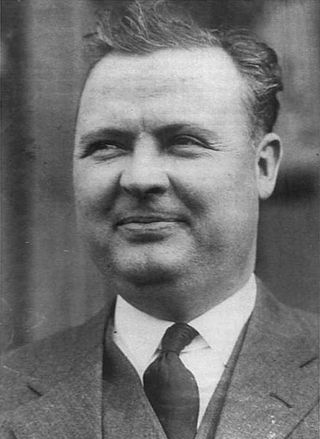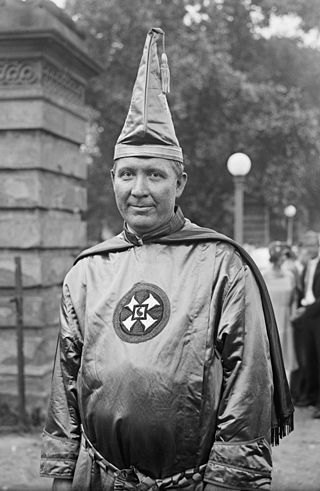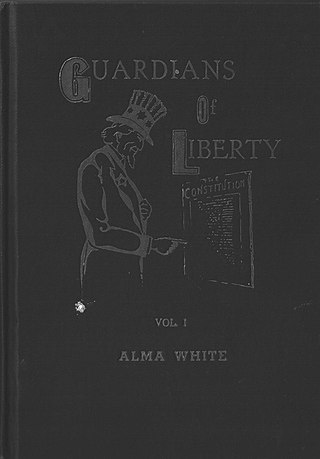Related Research Articles

The Ku Klux Klan, commonly shortened to the KKK or the Klan, is the name of several historical and current American white supremacist, far-right terrorist organizations and hate groups. The Klan was "the first organized terror movement in American history." Their primary targets are African Americans, Hispanics, Jews, Latinos, Asian Americans, Native Americans, Italian Americans, Irish Americans, and Catholics, as well as immigrants, leftists, homosexuals, Muslims, atheists, and abortion providers.

David Curtis "Steve" Stephenson was an American Ku Klux Klan leader, convicted rapist and murderer. In 1923 he was appointed Grand Dragon of the Indiana Klan and head of Klan recruiting for seven other states. Later that year, he led those groups to independence from the national KKK organization. Amassing wealth and political power in Indiana politics, he was one of the most prominent national Klan leaders. He had close relationships with numerous Indiana politicians, especially Governor Edward L. Jackson.
A Kleagle is an officer of the Ku Klux Klan whose main role is to recruit new members and must maintain the three guiding principles: recruit, maintain control, and safeguard.
The grand wizard is the national leader of several different Ku Klux Klan organizations in the United States and abroad.

William Joseph Simmons was an American preacher and fraternal organizer who founded and led the second Ku Klux Klan from Thanksgiving evening 1915 until being ousted in 1922 by Hiram Wesley Evans.

Hiram Wesley Evans was the Imperial Wizard of the Ku Klux Klan, an American white supremacist group, from 1922 to his death in 1939. A native of Alabama, Evans attended Vanderbilt University and became a dentist. He operated a small, moderately successful practice in Texas until 1920, when he joined the Klan's Dallas chapter. He quickly rose through the ranks and was part of a group that ousted William Joseph Simmons from the position of Imperial Wizard, the national leader, in November 1922. Evans succeeded him and sought to transform the group into a political power.
Daisy Douglas Barr was Imperial Empress (leader) of the Indiana Women's Ku Klux Klan (WKKK) in the early 1920s and an active member of the Women's Christian Temperance Union (WCTU). People were associated with both the KKK and the WCTU because the Ku Klux Klan was a very strong supporter and defender of temperance and National Prohibition. Professionally, she was a Quaker minister in two prominent churches, First Friends Church of New Castle, Indiana, and Friends Memorial Church in Muncie, Indiana. She served as the vice-chair of the Republican Committee in Indiana as well as president of the Indiana War Mother's organization. She was killed in a car wreck and her funeral was held in a Friends meeting.
Ku Klux Klan auxiliaries are organized groups that supplement, but do not directly integrate with the Ku Klux Klan. These auxiliaries include: Women of the Ku Klux Klan, The Jr. Ku Klux Klan, The Tri-K Girls, the American Crusaders, The Royal Riders of the Red Robe, The Ku Klux balla, and the Klan's Colored Man auxiliary.
Louis Ray Beam, Jr. is an American white supremacist, conspiracy theorist and neo-fascist.

Women of the Ku Klux Klan (WKKK), also known as Women's Ku Klux Klan, and Ladies of the Invisible Empire, held to many of the same political and social ideas of the KKK but functioned as a separate branch of the national organization with their own actions and ideas. While most women focused on the moral, civic, and educational agendas of the Klan, they also had considerable involvement in issues of race, class, ethnicity, gender, and religion. The women of the WKKK fought for educational and social reforms like other Progressive reformers but with extreme racism and intolerance.

The Indiana Klan was a branch of the Ku Klux Klan, a secret society in the United States that organized in 1915 to promote ideas of racial superiority and affect public affairs on issues of Prohibition, education, political corruption, and morality. It was strongly white supremacist against African Americans, Chinese Americans, and also Catholics and Jews, whose faiths were commonly associated with Irish, Italian, Balkan, and Slavic immigrants and their descendants. In Indiana, the Klan did not tend to practice overt violence but used intimidation in certain cases, whereas nationally the organization practiced illegal acts against minority ethnic and religious groups.

Edward Young Clarke was the Imperial Wizard pro tempore of the Ku Klux Klan from 1915 to 1922. Prior to his Klan activities, Clarke headed the Atlanta-based Southern Publicity Association. He later served as the president of Monarch Publishing, a book publishing company.
The New York World's exposé of the Ku Klux Klan brought national media to the operations and actions of the Ku Klux Klan beginning on September 6, 1921. The newspaper published a series of twenty one consecutive daily articles, edited by Herbert Bayard Swope, that discussed numerous aspects of Ku Klux Klan including rituals, recruitment methods, propaganda, and hypocrisies in logic. At least eighteen other newspapers nationwide picked up the coverage, which led to national discourse on the activities of the group. These publications included the St. Louis Post-Dispatch, Boston Globe, Pittsburgh Sun, The Plain Dealer (Cleveland), New Orleans Times-Picayune, Galveston News, Houston Chronicle, Seattle Times, Milwaukee Journal, Minneapolis Journal, Oklahoma City Oklahoman, Toledo Blade, Fort Wayne News-Sentinel, Syracuse Herald, Columbus Enquirer-Sun and the Albany Knickerbocker Press. The New York Times ran ads for the article series to increase exposure, while other large papers like the Baltimore Sun quickly picked up the article series instead of advertising for The World. The Ku Klux Klan announced shortly afterward that it would take legal action against all the publications that ran the article series for libel, seeking total damages of over $10 million. Following the exposé, Klan membership significantly increased.
Ku Klux Klan recruitment of members is the responsibility of 'Kleagles', as defined by "Ku Klux Klan: An Encyclopedia". They are organizers or recruiters, "appointed by an imperial wizard or his imperial representative to 'sex' the KKK among non-members". These members were paid 200 dollars per hour by the commission and received a portion of each new member's invitation fee. Recruitment of new KKK members entailed framing economic, political, and social structural changes in favour of and in line with KKK goals. These goals promoted "100 per cent Americanism" and benefits for white native-born Protestants. Informal ways Klansmen recruited members included "with eligible co-workers and personal friends and try to enlist them". Protestant teachers were also targeted for Klan membership.

Guardians of Liberty is a three volume set of books published in 1943 by Bishop Alma Bridwell White, author of over 35 books and founder of the Pillar of Fire Church. Guardians of Liberty is primarily devoted to summarizing White's vehement anti-Catholicism under the guise of patriotism. White also defends her historical support of and association with the Ku Klux Klan while significantly but not completely distancing herself from the Klan. Each of the three volumes corresponds to one of the three books White published in the 1920s promoting the Ku Klux Klan and her political views which in addition to anti-Catholicism also included nativism, anti-Semitism and white supremacy. In Guardians of Liberty, White removed most, but not all of the direct references to the Klan that had existed in her three 1920s books, both in the text and in the illustrations. In Volumes I and II, she removed most of the nativist, anti-Semitic and white supremacist ideology that had appeared in her predecessor books. However, in Guardians Volume III, she did retain edited versions of chapters promoting nativism, anti-Semitism and white supremacy.

Mary Elizabeth Tyler was an Atlanta public-relations professional who, along with Edward Young Clarke, founded the Southern Publicity Association. Their organization helped to turn the initially anemic second Ku Klux Klan into a mass-membership organization with a broader social agenda. They also worked with the Anti-Saloon League during the same period.

Ku Klux Klan (KKK) nomenclature has evolved over the order's nearly 160 years of existence. The titles and designations were first laid out in the original Klan's prescripts of 1867 and 1868, then revamped with William J. Simmons's Kloran of 1916. Subsequent Klans have made various modifications.

The Ku Klux Klan is an organization that expanded operations into Canada, based on the second Ku Klux Klan established in the United States in 1915. It operated as a fraternity, with chapters established in parts of Canada throughout the 1920s and early 1930s. The first registered provincial chapter was registered in Toronto in 1925 by two Americans and a Canadian. The organization was most successful in Saskatchewan, where it briefly influenced political activity and whose membership included a member of Parliament, Walter Davy Cowan.
The Fellowship Forum was an anti-Catholic publication that was mostly read by white, Protestant fraternalists. Historian Thomas R. Pegram has described the publication as a "Klan allied masonic journal". The link between Masons and the Klan was first announced in the Fellowship Forum. After the Klan hired the Southern Publicity Association to increase the organization's membership in the 1920s, Fellowship Forum readership increased—from 1,000 readers in 1921 to a circulation of over one million by 1927. The paper has been described as "an integral part of the resurgence of the KKK among white Americans in the 1920s".
References
- Blee, Kathleen M. (2008). Women of the Klan: Racism and Gender in the 1920s. University of California Press. ISBN 978-0-520-94292-9.
- Cooper Jr, William J.; Terrill, Thomas E.; Childers, Christopher (2016). The American South: A History, Volume II: From Reconstruction to the Present. Rowman & Littlefield. ISBN 978-1-4422-6230-0.
- Wade, Wyn Craig (1998). The Fiery Cross: The Ku Klux Klan in America. Oxford University Press. ISBN 978-0-19-512357-9.
- Flora, Joseph (2002). The Companion to Southern Literature . Louisiana State University Press. ISBN 9780807126929.